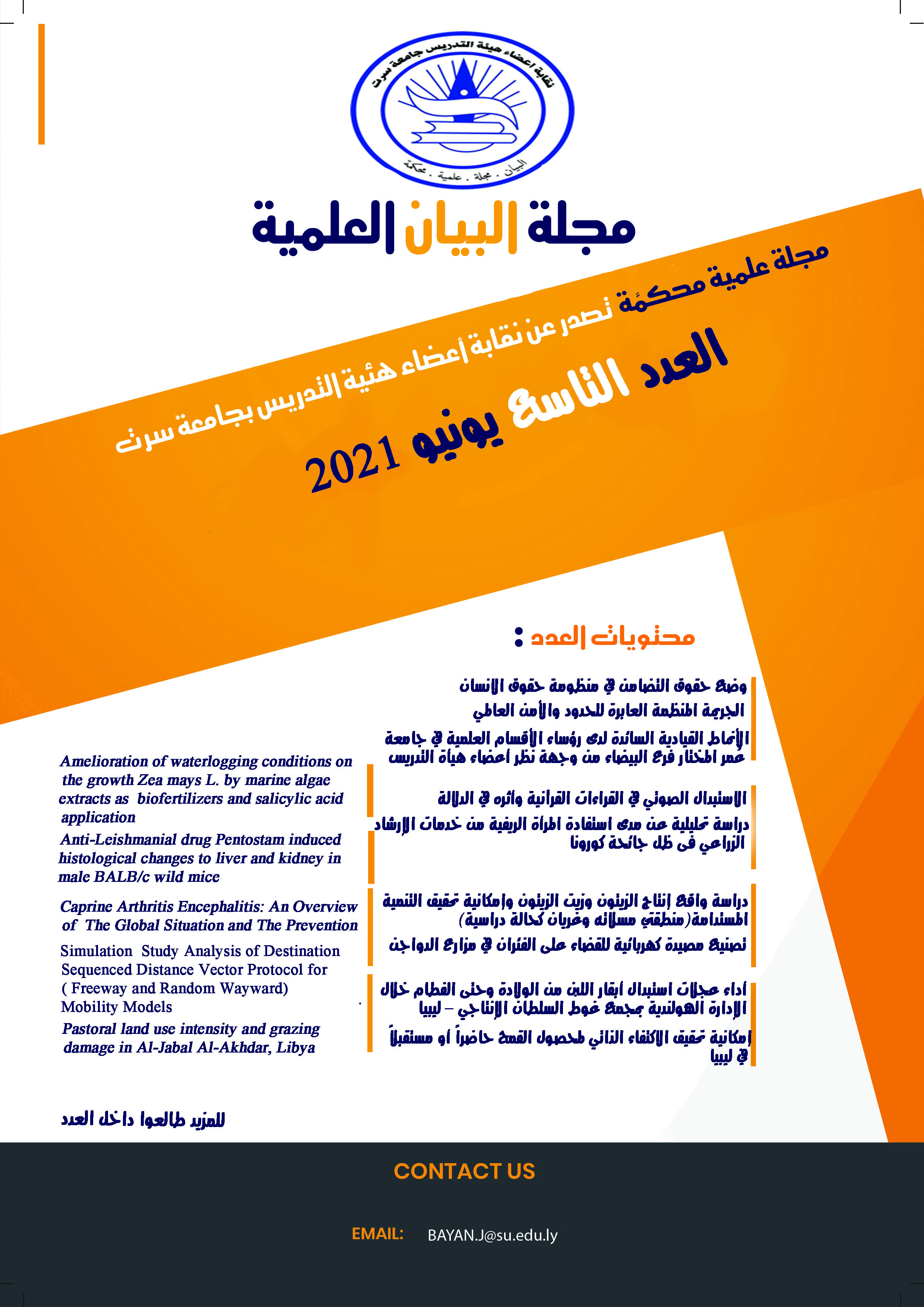Caprine Arthritis Encephalitis: An Overview of The Global Situation and The Prevention
DOI:
https://doi.org/10.37375/bsj.vi9.2314الكلمات المفتاحية:
Small Ruminant Lentiviruses,، Caprine Arthritis Encephalitis,، Maedi-Visna, Goatsالملخص
Globally, one of the diseases of economic impact and that affects the goat is Caprine Arthritis Encephalitis (CAE) caused by a virus of the Retroviridae family, genus Lentivirus, a group belongs to the Human Immunodeficiency Virus (HIV) and Ovine Progressive Pneumonia Virus (OPPV). Caprine Arthritis Encephalitis are a contagious febrile viral disease affecting the goats of all breeds, age or sex. CAE causing acute encephalitis, chronic non-suppurative arthritis of the tarsal, carpal joints, enlarged and severe hardening of the udder (indurative mastitis), with a bilateral nature that causes hypo or agalaxia, hypertrophied retromammary lymph nodes and chronic pneumonia. Caprine Arthritis Encephalitis Virus (CAEV) like all lentiviruses, has a diameter of 80-130nm enveloped particles with a dense conical nucleus, contains two copies of single-stranded genomic RNA and several viral proteins with positive polarity characterised by an extreme slowness of it is replication processes. The virus is very closely related to the Maedi-Visna Virus (MVV) which causes a very similar disease in sheep. Management and hygiene at the level of milking equipment and utensils are common act to more than one individual can reduce the transmission of contagious agalaxia in a herd. Newborns should be fed colostrum from uninfected females or with pasteurized milk. Cleaning and regular disinfection of pens are sanitary measurements planned as a prevention strategy.
المراجع
References
Olech, M.; Rachid, N.; Croisé, B.; Kuzmak, J. and Valas, S. (2012). Genetic and antigenic characterization of small ruminant lentiviruses circulating in Poland. Virus. Res., 163: 528-536.
Brinkhof, J. M. A.; Moll, L. D.; Van Maanen, C. and Houwers, D. J. (2010). Use of serology and polymerase chain reaction for the rapid eradication of small ruminant lentivirus infections from a sheep flock: A case report. Res. Vet. Sci., 88: 41-43.
Crawford, T. B.; Adams, D. S.; Cheevers, W. P. and Cork, L. C. (1980a). Chronic arthritis in goats caused by a retrovirus. Science., 207: 997-999.
Crawford, T. B., Adams, D. S., Sande, R. D., Gorham, J. R. and Henson, J. B. (1980b). The connective tissue component of the caprine arthritis encephalitis syndrome., Am. J. Pathol., 100 (2): 443-450.
Knowles, D. and Herrmann, L. M. (2008). Caprine arthritis–encephalitis and Maedi-Visna. In: OIE Biological Commission (Ed.), Manual of Diagnostic Tests and Vaccines for Terrestrial Animals (Mammals, Birds, and Bees), vol. 2, 6th Ed. World organization for Animal Health (OIE), pp: 983-991, Chapter 2. 7. 3/4.
Souza, K. C. (2013). Transmission of the caprine arthritis–encephalitis virus through artificial insemination. small ruminant research, 193-198.
Nalbert, T.; Czopowicz, M.; Szaluś-Jordanow, O.; Witkowski, L.; Moroz, A.; Mickiewicz, M.; Markowska-Daniel, I.; Słoniewska, D.; Bagnicka, E.; Kaba, J.; (2019). Effect of Immediately-After-Birth Weaning on the Development of Goat Kids Born to Small Ruminant Lentivirus-Positive Dams. Animals (Basel);9:822.
Blacklaws, B. A. (2012). Small Ruminant Lentiviruses: Immunopathogenesis of Visna-Maedi and Caprine Arthritis Encephalitis Virus. Comparative Immunology, Microbiology and Infectious Diseases, 259-269.
Marta Pittavino, L. F. (2014). A CAEV Epidemiological Model for Goat Breeding. Applied Mathematics and Computation, 156-163.
O’Keefe, Eric P. (2013). Nucleic Acid Delivery: Lentiviral and Retroviral vectors. Materials and Methods. 3:174.
Gendelman, H. E.; Narayan, O.; Molineaux, S.; Clements, J. E. and Ghotbi, Z. (1985). Slow, persistent replication of lentiviruses: Role of tissue macrophages and macrophage precursors in bone marrow. Proc. Natl. Acad. Sci., USA 82: 7086-7090.
Lamara, A. (2002). Early Embryonic Cells From in vivo-Produced Goat Embryos Transmit The Caprine Arthritis–Encephalitis Virus (CAEV). Theriogenology, 1153-1163.
Radostits, O. M.; Blood, D. C. and Gay, C. C. (2000). In: Veterinary Medicine: A Textbook of the Diseases of Cattle, Sheep, Pigs, Goats and Horses. 8th Ed. Bailliere Tindall.
Martinez Rodriguez, H.A.; Ramirez Alvarez, H.; Tortora Perez, J.; Aguilar Setien, A.; Garrido Farina, G.I.; Montaraz Crespo, J.A. (2005). Effect of the caprine arthritis encephalitis virus in the reproductive system of male goats. Veterinaria Mexico 36(2): 159-176.














